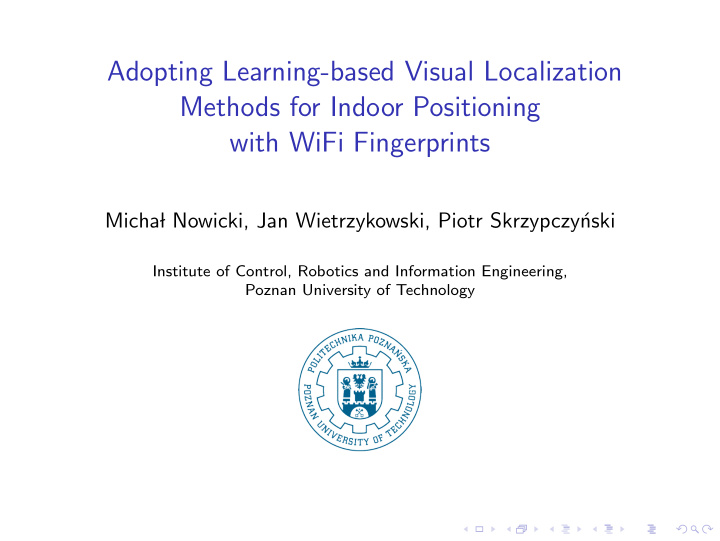



Adopting Learning-based Visual Localization Methods for Indoor Positioning with WiFi Fingerprints Micha� l Nowicki, Jan Wietrzykowski, Piotr Skrzypczy´ nski Institute of Control, Robotics and Information Engineering, Poznan University of Technology
Positioning with WiFi fingerprints Figure : At first we determine the building
Positioning with WiFi fingerprints Figure : Then, we deterimine the floor in this building
Positioning with WiFi fingerprints Figure : Finally, we localize the agent within this floor
Issues and concepts in WiFi-based positioning Issues ◮ Problems in choosing features for classification ◮ A small fraction of all networks (APs) is shared across all the scans. ◮ Labeled training data are hard to acquire. ◮ Environments are non-stationary (life-long learning is needed). Concept Similar problems are present in appearance-based localization. Why not adopt vision-based methods to WiFi scans ?
UJIIndoorLoc WiFi dataset ◮ Publicly available dataset acquired in three buildings at the Jaume I University (110 000 m 2 ). ◮ The dataset was used in EvAAL 2014 competition. ◮ Contains 19937 scans in the training set, and 1111 scans in the validation set. ◮ 520 different WiFi networks were observed.
FAB-MAP ◮ Appearance-based localization from whole images. ◮ Uses the bag of visual words concept to describe the point features that are meaningful. ◮ Uses the Chow-Liu tree algorithm to learn the visual vocabulary.
Mapping the WiFi scans to binary feature vectors ◮ Mapping of the received signal strength (RSSI) to binary strings. ◮ Choosen bin width is 10 dBm. ◮ Signal stength lies in the �− 110 dBm , − 10 dBm � interval. ◮ If the i -the network is not present in the given scan 0 is assigned to all bins of the i -th vector.
Training of the modified FAB-MAP ◮ Parameters: ◮ PzGe: p ( z i = 1 | e i = 1) ◮ PzGne: p ( z i = 1 | e i = 0) ◮ UJIIndoorLoc training data are divided into a training set and a validation set. ◮ Original UJIIndoorLoc validation set is used as test data.
Results obtained for the UJIIndoorLoc data correct floor average position PzGe PzGne detections error [m] 0.4916 0.0550 0.81 9.96 0.4916 0.0055 0.89 8.21 0.4916 0.0006 0.91 8.40
Deep Neural Network for building and floor classification Figure : DNN containing autoencoders (SAE) and three hidden layers. The output is the probability of being located in the given building and floor
DNN for agent’s position regression problem Figure : Position regression network with three hidden layers Table : Comparison of DNN results to other systems used at EvAAL position error [m] MOSAIC HFTS RTLS@UM ICSL DNN XY median error 6.72 6.99 4.57 5.88 ∼ 10 average error 11.64 8.49 6.20 7.67 ∼ 11
New approaches to positioning using DNN DNN for position classification (DNN Class) Classification of the agent’s position to one of the cells in a regular grid of known size. Each cell is treated as a separate class. Position errors are bounded to the cell size.
New approaches to positioning using DNN DNN for learning node membership (DNN Fuzzy) Regular grid of nodes is imposed on the floor map. Each node is treated as a separate class. For each training sample the degree of membership (in the sense of a fuzzy membership function) to four nearest nodes is computed as the inverse Euclidean distance to the given node. The DNN learns a normalized metrics of membership to the nodes.
Augmenting the training data with generated WiFi scans Figure : For each point from a regular grid we look for the closest WiFi scans from the labeled training set, and then we compute a new WiFi scan using the average weighted signal strength of the nearest neighbors
Results for generated WiFi scans Figure : The cumulative distribution function (CDF) of the WiFi scans vs. the positioning error shows localization results for different approaches and parameter values. The k parameter defines the number of neighbors in the WKNN algorithm, while g stands for the distance between nodes of the mesh in the fuzzy DNN method
Summary Conclusions: ◮ FAB-MAP adopted to WiFi data produces results comparable to the standard WKNN without the need for manual tuning. ◮ Both FAB-MAP and DNN are effective in the building/floor recognition task (classification). ◮ DNN XY and DNN Class cannot achieve satisfactory positioning results. ◮ DNN Fuzzy also obtains worse results than the standard WKNN for small training datasets. ◮ Augmented training data allow the DNN Fuzzy architecture to obtain results comparable to WKNN.
Summary Acknowledgement: This research was funded by the National Science Centre in Poland in years 2016-2019 under the grant 2015/17/N/ST6/01228.
Recommend
More recommend